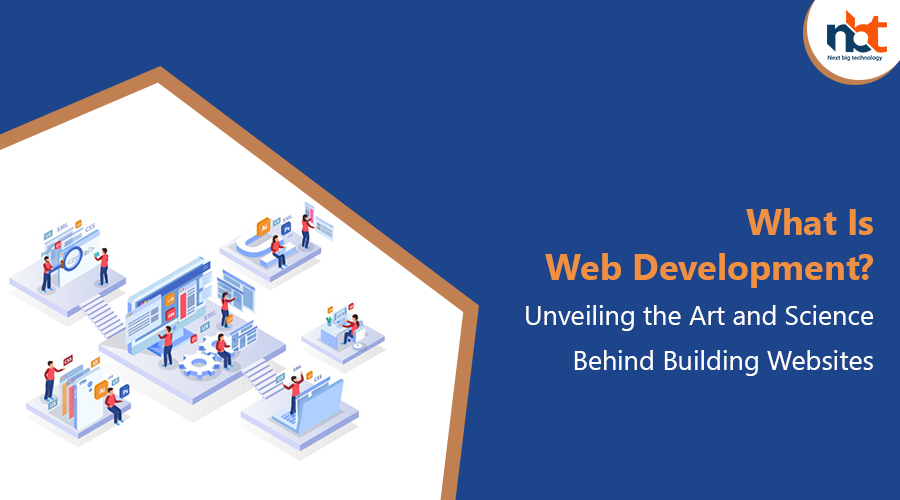In today’s digital era, where the internet is an integral part of our lives, web development plays a vital role in bringing websites to life. From simple static pages to complex web applications, web development encompasses a wide range of skills and technologies. In this blog post, we’ll delve into the world of web development, uncovering its intricacies, and exploring the art and science behind building websites.
Table of Contents
What Is Web Development?
Web development refers to the process of creating and maintaining websites. It involves a combination of programming, designing, and other technical skills to build visually appealing, interactive, and functional websites. Web developers work with various technologies and programming languages to bring web designs to life, ensuring websites are user-friendly, responsive, and optimized for performance.
The Components of Web Development
- Front-end Development: Front-end development focuses on the visual and interactive aspects of a website that users see and interact with. Front-end developers use languages like HTML (Hypertext Markup Language), CSS (Cascading Style Sheets), and JavaScript to create the structure, design, and functionality of a website’s user interface. They ensure that websites are responsive, accessible, and provide a seamless user experience across different devices and browsers.
- Back-end Development: Back-end development deals with the behind-the-scenes functionality of a website. Back-end developers work with server-side programming languages like PHP, Python, Ruby, or Node.js to handle data processing, database management, and server-side logic. They build and maintain the server infrastructure that powers the website, ensuring data security, efficiency, and seamless communication between the server and the front-end.
- Full-stack Development: Full-stack developers are proficient in both front-end and back-end development. They have a comprehensive understanding of all the layers involved in web development, from the user interface to the server and database. Full-stack developers have the ability to handle both the client-side and server-side aspects of a website, making them versatile and capable of working on end-to-end web development projects.
- Web Design: Web design focuses on creating visually appealing and user-friendly interfaces for websites. Web designers use design principles, typography, color theory, and graphic design skills to craft aesthetically pleasing layouts and interfaces. They collaborate with front-end developers to ensure the design is implemented accurately, providing an intuitive and engaging user experience.
The Web Development Process
Web development follows a systematic process that involves several stages from planning to deployment. Here’s a general overview of the web development process:
- Project Planning: In this initial stage, web developers gather requirements, define the website’s goals and objectives, and determine the target audience. They conduct market research, competitor analysis, and define the website’s features, functionality, and scope. Project planning includes creating wireframes, sitemaps, and project timelines to guide the development process.
- Design: Web designers create the visual elements of the website, including the layout, color scheme, typography, and graphical assets. They collaborate with clients to ensure the design aligns with their brand identity and meets their expectations. Design tools such as Adobe Photoshop, Sketch, or Figma are often used to create mockups and prototypes.
- Front-end Development: Front-end developers take the design and convert it into a fully functional website. They use HTML, CSS, and JavaScript to implement the user interface, create responsive layouts, and add interactivity. They optimize the website for performance, ensuring fast page load times and smooth user interactions.
- Back-end Development: Back-end developers work on the server-side of the website, handling data processing, database management, and server logic. They develop server applications using programming languages like PHP, Python, Ruby, or Node.js. They integrate with databases, create APIs (Application Programming Interfaces), and implement security measures to protect user data.
- Testing and Quality Assurance: Web developers conduct rigorous testing to ensure the website functions as intended. They perform functional testing, compatibility testing across different browsers and devices, and validate the website’s performance. They also identify and fix any bugs or issues that may arise during the testing phase to ensure a smooth user experience.
- Deployment and Maintenance: Once the website has been thoroughly tested and approved, it is deployed to a hosting environment, making it accessible to users. Web developers ensure the website is properly configured and optimized for the hosting environment. They also provide ongoing maintenance, including updates, bug fixes, and security patches, to keep the website running smoothly and securely.
Web Development Technologies and Frameworks
Web development involves working with various technologies, frameworks, and tools to streamline the development process and enhance efficiency. Some popular technologies and frameworks used in web development include:
- HTML5 and CSS3: The latest versions of HTML and CSS that provide enhanced functionality, multimedia support, and more advanced styling options.
- JavaScript and Libraries/Frameworks: JavaScript is a versatile programming language used for client-side interactivity. Popular JavaScript libraries and frameworks like React, Angular, or Vue.js provide pre-built components and tools for faster and more efficient development.
- Content Management Systems (CMS): CMS platforms like WordPress, Drupal, or Joomla provide a user-friendly interface for managing website content and allow non-technical users to update and maintain their websites easily.
- Server-side Technologies: Server-side technologies like PHP, Python, Ruby, or Node.js are used to handle server-side logic, process data, and communicate with databases.
- Databases: Databases like MySQL, PostgreSQL, or MongoDB are used to store and retrieve data for web applications.
- Version Control Systems: Version control systems like Git enable collaboration, code management, and tracking changes during the development process.
Conclusion
Web development is an intricate process that combines creativity, technical expertise, and problem-solving skills to build visually appealing, interactive, and functional websites. Whether it’s front-end development, back-end development, or full-stack development, each component contributes to the overall success of a website. By leveraging various technologies, frameworks, and methodologies, web developers bring designs to life, ensuring websites are user-friendly, responsive, and optimized for performance. So, the next time you visit a website and marvel at its seamless functionality, remember the art and science behind web development that made it possible.












